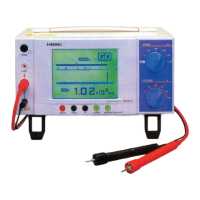21
4) Confirm that the accessory shorting plug is inserted into HV-EN
connector on the rear the unit.
5) Leave the Rx /+ measuring terminals free at this stage – do not connect
the measuring rods and the sample to be measured to the terminals.
6) Set the RANGE selector switch to the ×1 position – the minimum
Multiplier.
7) Set the VOLTAGE SELECTOR switches to the lowest voltage available.
8) Turn the POWER switch ON.
Allow the unit to warm for a minimum of 30 seconds to obtain the
specified performance. However, a measurement can be done after a
warm-up of several seconds.
5.2 Self-calibration 1
1) Set the RANGE switch to the CAL position. (The display will show CAL1.)
The calibration will be verified by the internal calibration circuit. Verify
that the measured data display indicates a value within the range of .970
to 1.03.
2) If the value falls within the normal range, the self-calibration is complete.
Set the RANGE switch to a position other than
CAL. (If self-calibration 1
yields a result within the normal range, there is no need to perform
self-calibration 2.)
5.3 Self-calibration 2
1) Press the SELECT switch while CAL1 is being displayed. (The display will
show CAL2; see “4-4 Measurement Condition Setting Display” for more
information.)
2) Increase the RANGE switch to the
×10
2
range.
3) Verify that the screen is displaying values with 5 digits and press the
SELECT switch.
4) This completes self-calibration 2. Repeat self-calibration 1 and verify
that the value falls within the proper range.

